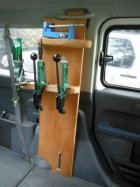Your using much faster powder. Also Palma is shot almost exclusively in hot weather. Lapua does warn its customers never to use Palma brass for hunting as it can cause hang fires. In one of Brian Litz books he demonstrates with a 308W that slower powders with not enough primer detonation increased SD measurably.
As I said in an earlier post, this whole area is riddled with apparent contradictions and exceptions to rules. Nevertheless, we in the UK shoot BR, F-Class, and 'Target Rifle' (ie 'Palma' at different ranges) all year round, and although our winters are mild by north American or continental European standards, we will shoot in ambient temperatures barely above freezing, and Palma brass still works fine, although I suspect it is just becoming marginal with some powders. In the Palma Teams' Long Range shooting forum Dan Simpson went through the exhaustive test procedures that were employed just because of such likely problems or objections. One was to put the standard Palma VarGet load ammo in a fridge overnight and take it it to the range in a cool box. No problems, so that was repeated putting the ammo overnight in a freezer - again no problems. I can quite understand Lapua advising 'not for hunting' as some continental European, Scandinavian and north American hunting season temperatures aren't just below freezing, they are way below. After all, the military think the same way too as they must with Arctic warfare and similar a possibility. So, the PPC's ancestor the 7.62X39mm uses a large rifle primer as standard to guarantee reliability, but you don't see many BR competitors re-adopting this form.
As to 'slower burning' powders, that depends on how one defines slow burning. The norm in the UK is to use slower burners than H4895 and VarGet with many 308 loads especially with 185gn and heavier bullets. Viht N150 is a very common choice, and some people use N550 which is harder to ignite, again all year round. In reformed Palma brass, 260 Rem, 7mm-08 Rem and similar all use slower burners perfectly happily with this brass. I use nearly 50gn Viht N160 in my SRP 7mm-08 loads and have no issues with it over two years of competition. In testing / load development, I ran N165 with literally as much powder as could be got into the case (in a long freebore chamber for 3-inch COALs) a shade under 52gn. You don't get much slower burning than N165 without going onto the propellants designed for really over-bore capacity ultra magnums and the 50 BMG. ES/SD values were consistently good, and you don't see that if suffering even the most minor of ignition issues. And the weather wan't 'hot' by any means - a hot day on Diggle Ranges located 1,000 ft ASL in the north of England is 20-deg C (68F) and we see those infrequently enough in a year to count them on our fingers. 14-18 deg C is the typical summer ambient temperature range.












